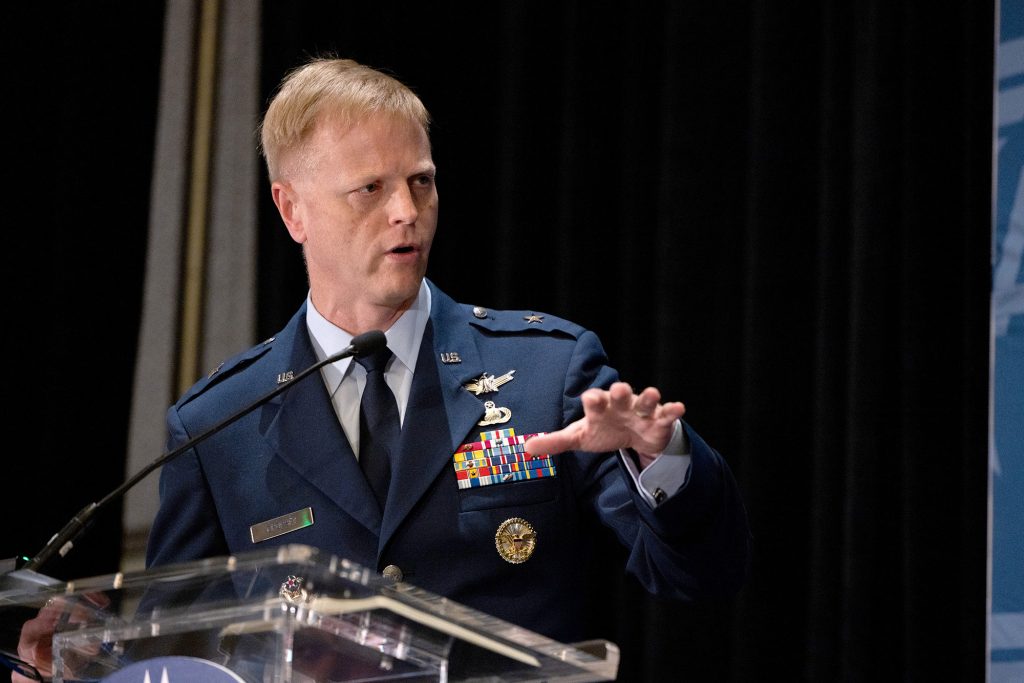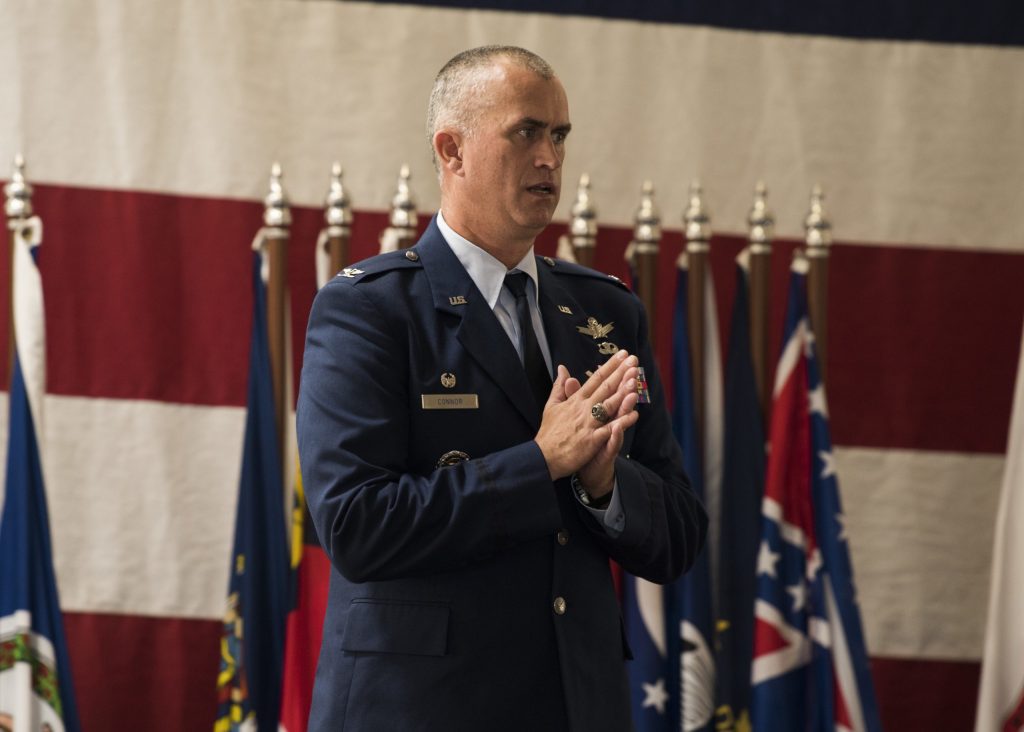Nearly 20 Air Force brigadier generals have been nominated to pin on second stars, the Pentagon announced July 10, including the service’s acquisition czar for C3 and battle management and the head of a new office created to oversee the modernization of the Air Force’s intercontinental ballistic missile fleet.
All 18 nominees will stay in their current roles while moving up a rank if confirmed.
Brig. Gen. Luke C.G. Cropsey became the first ever program executive for command, control, and communications/battle management nearly two years ago. Initially, Cropsey was focused on finding ways to operationalize the Advanced Battle Management System concept, but over time, his scope has expanded to encompass a Department of the Air Force-wide “DAF Battle Network” that covers all the ways the Air Force and Space Force connect sensors, shooters, and commanders around the globe.

Air Force Secretary Frank Kendall has called the job “the hardest acquisition job I’ve ever given anybody,” and Cropsey has admitted the vast scale of the challenge. However, he has also said his office has succeeded in starting to field new operational capabilities for Airmen and Guardians.
Cropsey—or his successor as C3BM czar—will command the new Air Force Information Dominance Systems Center, Air Force Materiel Command has said.
Also slated for a promotion is Brig. Gen. Colin J. Connor. Late last year, Air Force Global Strike Command set up an “A10” directorate for ICBM modernization, headed up by Connor. The move also satisfied a requirement in the 2023 National Defense Authorization Act that the Air Force establish an ICBM Modernization Site Activation Task Force to “oversee and coordinate” the planning, construction, and installation that will go into getting Sentinel online while keeping the existing Minuteman III missiles viable.
Like Cropsey, Connor also faces a large task in preparing for the massive Sentinel program.
“It is the most complex thing we’ve done, I’ll say, since the 1960s,” Connor said last fall. “And I would say even then, because of technology that we’re trying to equip, whether it’s [nuclear command, control, and communications] technology, digital engineering aspects to it, it’s even different than what was done in the ’60s.”

Connor’s comments came before the Air Force declared “critical” cost and schedule overruns on the Sentinel, prompting a six-month review. That review, recently concluded, will lead the program to be restructured, and officials said launch facility designs will be scaled back. Infrastructure is seen as the driving force behind most of the program’s cost increases.
Other Air Force one-stars nominated include:
- Brig. Gen. Steven G. Behmer: Deputy commanding general, Security Assistance Group – Ukraine, U.S. European Command, Wiesbaden, Germany.
- Brig. Gen. William D. Betts: Director, Operations, Ninth Air Force, Air Forces Central; and director, U.S. Central Command Combined Air Operations Center, Air Combat Command, Shaw Air Force Base, South Carolina.
- Brig. Gen. Joseph L. Campo: Director, Operations, Strategic Deterrence, and Nuclear Integration, U.S. Air Forces in Europe-Air Forces Africa, Ramstein Air Base, Germany.
- Brig. Gen. Robert D. Davis: Director, Operations, Headquarters North American Aerospace Defense Command, Peterson Space Force Base, Colorado.
- Brig. Gen. Gerald A. Donohue: Director, Operations, Strategic Deterrence, and Nuclear Integration, Headquarters Air Mobility Command, Scott Air Force Base, Illinois.
- Brig. Gen. Aaron D. Drake: Ssenior defense official/defense attaché-Russia, Defense Intelligence Agency, Moscow, Russia.
- Brig. Gen. Lyle K. Drew: Director, Logistics, Civil Engineering and Force Protection, and Nuclear Integration, Headquarters Air Force Materiel Command, Wright-Patterson Air Force Base, Ohio.
- Brig. Gen. Russell D. Driggers: Commander, 502nd Air Base Wing, Air Education and Training Command, Joint Base San Antonio-Fort Sam Houston, Texas.
- Brig. Gen. Michael R. Drowley: Director, Joint Training and Exercises, Headquarters U.S. Indo-Pacific Command, Camp H.M. Smith, Hawaii.
- Brig. Gen. David S. Eaglin: Deputy director, Operations, Headquarters U.S. Indo-Pacific Command, Camp H.M. Smith, Hawaii.
- Brig. Gen. Gregory Kreuder: Director, F-35 Integration Office, Headquarters U.S. Air Force, Pentagon, Washington, D.C.
- Brig. Gen. Joseph D. Kunkel: Director, Air Force Warfighting Integration Capability, deputy chief of staff, Strategy, Integration, and Requirements, Headquarters U.S. Air Force, Pentagon, Washington, D.C.
- Brig. Gen. Jefferson J. O’Donnell: Commander, Air Force Personnel Center, deputy chief of staff, Manpower, Personnel and Services, Joint Base San Antonio-Randolph, Texas.
- Brig. Gen. Derek J. O’Malley: Deputy director, Operations, Headquarters North American Aerospace Defense Command, Peterson Space Force Base, Colorado.
- Brig. Gen. Neil R. Richardson: Deputy director, Strategic Planning and Policy, Headquarters U.S. Indo-Pacific Command, Camp H.M. Smith, Hawaii.
- Brig. Gen. Frank R. Verdugo: Director, Financial Management, Headquarters Air Force Materiel Command, Wright-Patterson Air Force Base, Ohio.
In addition to them, two colonels were nominated to become brigadier generals:
- Col. John M. Schutte: Deputy chief of staff, Headquarters U.S. European Command, Wiesbaden, Germany.
- Col. Lucas J. Teel: Commander, 332nd Air Expeditionary Wing, Air Combat Command, Muwaffaq Salti Air Base, Jordan.
